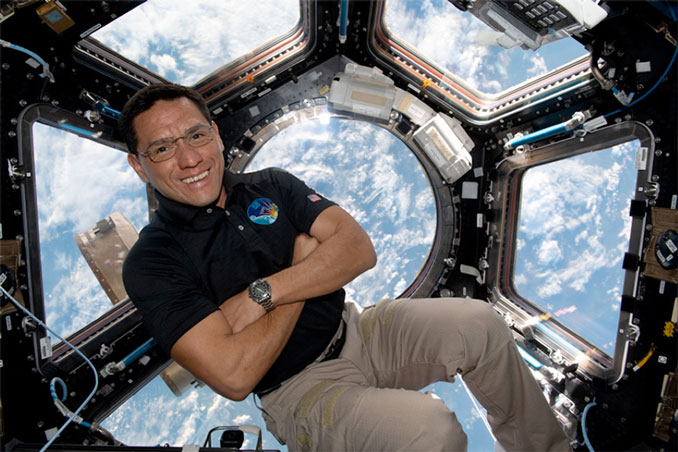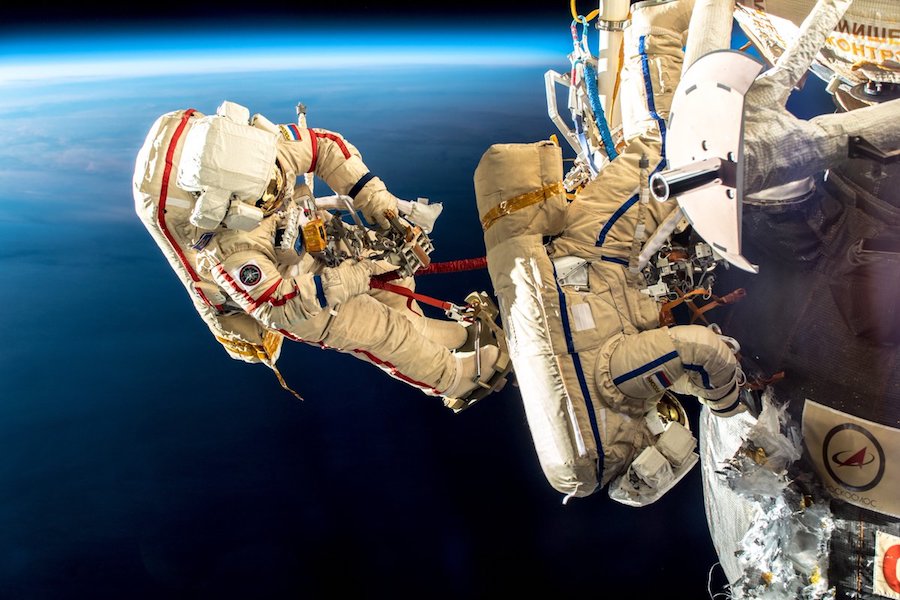Space News & Blog Articles
Cosmonaut Oleg Kononenko reaches 1,000 cumulative days in space
 Expedition 70 NASA astronaut Loral O’Hara, left, Roscosmos cosmonauts Oleg Kononenko, and Nikolai Chub, right, are seen in quarantine behind glass during a press conference, Thursday, Sept. 14, 2023 at the Cosmonaut Hotel in Baikonur, Kazakhstan. O’Hara, Kononenko, Chub are launched aboard their Soyuz MS-24 spacecraft on Sept. 15. Image: NASA/Bill Ingalls
Expedition 70 NASA astronaut Loral O’Hara, left, Roscosmos cosmonauts Oleg Kononenko, and Nikolai Chub, right, are seen in quarantine behind glass during a press conference, Thursday, Sept. 14, 2023 at the Cosmonaut Hotel in Baikonur, Kazakhstan. O’Hara, Kononenko, Chub are launched aboard their Soyuz MS-24 spacecraft on Sept. 15. Image: NASA/Bill Ingalls
Russian cosmonaut Oleg Kononenko continues to cement a place in the annals of space history with his historic mission on board the International Space Station. On Wednesday, he became the first person to reach 1,000 cumulative days in space.
The milestone comes amid his fifth flight to space and during his third stint as the commander of the ISS. Back in February, Kononenko broke the cumulative in-space record of 878 days, which was previously held by former cosmonaut Gennady Padalka.
His most recent trip to the orbiting laboratory began with a launch aboard the Soyuz MS-24 spacecraft on Sept. 15, 2023, alongside cosmonaut Nikolai Chub and NASA astronaut Loral O’Hara. He’s scheduled to return with Chub and NASA astronaut Tracy Dyson in September 2024.
Spaceflight Now spoke with Emmanuel Urquieta, the former chief medical officer of the NASA-funded Translational Research Institute for Space Health (TRISH), which is led by Baylor College of Medicine. He was recently tapped by the University of Central Florida (UCF) to serve as the vice chair for aerospace medicine in its Department of Internal Medicine.
“It takes a special kind of person to be able to achieve such a record,” Urquieta said. “It’s a long time, but I think that it is one of those data points that I hope that we will start getting more of those in the future.”
 NASA astronaut Matthew Dominick (center) poses for a portrait with Expedition 71 Commander Oleg Kononenko (left) and Flight Engineer Nikolai Chub, both Roscosmos cosmonauts. Dominick was inside the Poisk module assisting Kononenko and Chub as they prepared their Orlan spacesuits for a spacewalk to configure hardware and install experiments on the International Space Station. Image: NASA
NASA astronaut Matthew Dominick (center) poses for a portrait with Expedition 71 Commander Oleg Kononenko (left) and Flight Engineer Nikolai Chub, both Roscosmos cosmonauts. Dominick was inside the Poisk module assisting Kononenko and Chub as they prepared their Orlan spacesuits for a spacewalk to configure hardware and install experiments on the International Space Station. Image: NASA
Urquieta participated in research concerning a number of astronauts who have traveled to low Earth orbit for varying lengths of time, including the first all-civilian mission, called Inspiration4, in 2021. He pointed to five main areas of research that he and his colleagues hone in on when it comes to better understanding long duration spaceflight:
Communication across a large distance from Earth Radiation exposure Isolation and confinement Ultra gravity fields (i.e. being in a zero g environment) Living in a hostile and closed environmentHe said Kononenko provides a unique opportunity to further our understanding of the impacts of long-duration spaceflight on the human body.
“Even though people might ask, ‘Ok, well, it’s not a single mission, right? There were multiple missions that made that 1,000 days? Well, still in that case, it is extremely relevant to us to understand how multiple exposures to spaceflight have had impacts, in what extent, in the different physiological levels,” Urquieta said.
“I’m sure that there will be a lot of research coming up in the future when he comes back to Earth and I’m sure that there will be a very long follow up with him, you know, days, months and years after, to try really to understand these very unique data points.”
With an eye on long-duration missions on the surface of the Moon in the 2030s and expeditions to Mars further down the road, Urquieta said it’s important to learn as much as possible about things like radiation exposure, eye health, bone loss and space motion sickness.
He said much of that learning comes from the six-month crew rotation missions onboard the ISS.
“When you extrapolate the data that we have from six-month missions to 900 days, there’s still a huge gap of data that we need to fulfill, that we need to get so that we can safely say that, ok, we have enough data that we can confidently say that we’re able to send someone to Mars and make sure that that person is going to come back as healthy as he or she left Earth,” Urquieta said.
 Russian cosmonauts Oleg Kononenko and Nikolai Chub work outside the International Space Station on Oct. 25, 2023. Image: NASA TV
Russian cosmonauts Oleg Kononenko and Nikolai Chub work outside the International Space Station on Oct. 25, 2023. Image: NASA TV
Unrivaled record
After Kononenko, the next most experienced flier, who is also currently eligible for future missions, is former NASA astronaut Peggy Whitson. She currently works as a private astronaut at Houston-based Axiom Space and notched more than 675 days on orbit, including her first mission as a private commander of Ax-2 in 2023.
The active duty NASA astronaut who comes closest to Kononenko’s record is Mark Vande Hei who spent a total of more than 523 days in orbit during two separate missions.
Currently, NASA isn’t planning missions to the ISS longer than about six months. The agency uses the SpaceX Crew Dragon to ferry its astronauts to space for these long-duration missions before they hand over on-orbit duties to the following crew. The agency plans to use Boeing’s Starliner spacecraft to do the same, once it is certified in the aftermath of the Crew Flight Test.
The most recent instance of a NASA astronaut spending a continuous year in space was Frank Rubio’s first trip to orbit. His 370 days on orbit were unplanned due to an issue with the Soyuz vehicle that was deemed unsafe to return him and his Russian colleagues to Earth.
 Rubio takes in the view of Earth 260 miles below while floating in the space station’s multi-window cupola compartment. Image: NASA.
Rubio takes in the view of Earth 260 miles below while floating in the space station’s multi-window cupola compartment. Image: NASA.
Urquieta said he would like to see more year-long missions planned as time goes on and NASA gets closer to sending humans to Mars. But he said the six-month missions are still valuable as the Artemis program prepares to send humans back to the Moon for increasingly longer stays.
“Those late Artemis missions are going to be longer in duration and those ones are going to be a testbed for Mars. So, I expect that those late Artemis missions will be increasing in duration, maybe to the extent of longer than a year,” Urquieta said. “But for the Moon, I think that six-month missions on the ISS still provides valuable and reliable information to keep informing the decisions for Moon landing or lunar exploration-type of missions.”
And even if Kononenko’s towering record stands for years to come, Urquieta said the more we learn about the human body in space, the better we can treat older humans here on Earth and different types of diseases. Not only that, but he said working more with medicine in space can offer better solutions when it comes to healthcare for those in homes and communities that are far removed from hospitals or clinics.
“Even still here in the U.S., there are lots of populations that are 100 miles away from the closest hospital and from the closest pharmacy,” Urquieta said. “Imagine that capability of not having to see a physician and you will still be able to have some initial medical decision support and initiate the treatment.”
“I think that will be extremely, extremely relevant to underserved and isolated populations, not only in the U.S., but really in the world.”
 Russian cosmonauts Oleg Kononenko (red stripes) and Sergey Prokopyev (blue stripes) inspect the site of a repaired air leak on the Soyuz MS-09 spacecraft on a Dec. 11, 2018, spacewalk outside the International Space Station. Credit: NASA/ESA/Alexander Gerst
Russian cosmonauts Oleg Kononenko (red stripes) and Sergey Prokopyev (blue stripes) inspect the site of a repaired air leak on the Soyuz MS-09 spacecraft on a Dec. 11, 2018, spacewalk outside the International Space Station. Credit: NASA/ESA/Alexander Gerst
When you subscribe to the SpaceZE News Feed, we will send you an e-mail when there are new updates on the site so you wouldn't miss them.

